|
There
continue to be some wide swings in reported yields. Corn yields have
ranged from around 90 bushels to over 200, with most recently
harvested corn in the 160- to 180-bushel range. For soybeans, many
of the fields being recently harvested are in the 50- to 65-bushel
range.
It
seems like no matter how early we start harvest, Mother Nature doesn’t
allow us to finish much before the last part of October or the first
of November.
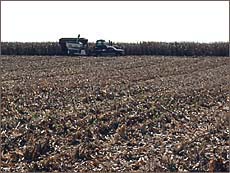
Leasing
in central Illinois
One
of the topics that is always talked about, but less often addressed,
is farm leasing. Most of the talk centers on what cash rents are and
modifications to the traditional 50-50 crop share lease. In the
interest of focusing thoughts on leasing, following are some points
from a recent newsletter put out by Dale Lattz from the University
of Illinois.
Central
Illinois grain farms have about 14 percent of the land in the
operation owned by the operator; 65 percent of the land is rented on
a crop share basis; and 21 percent is rented on a cash lease basis.
Cash rented ground has increased about 1 percent a year for the last
five years at the expense of ground rented on shares.
Many
landlords and tenants are currently reviewing their lease
situations. There are advantages and disadvantages to any leasing
arrangement. From the landlord’s perspective, there can be
significant impacts on how income is treated for self-employment tax
and how ground values are calculated for estate tax (if something
happens to you). Before making any changes, you should contact your
tax planner or attorney.
[to top of second column in this
article]
|
The
other thing that is considered at this time of year is the amount of
cash rent to charge. I don’t know if there is such a thing as a
"fair" lease, but we should strive to have an equitable
lease. There is also no such thing as an "average" cash
rent. The range of cash rents in the county has over a $100-per-acre
spread. Each rental arrangement should be negotiated between parties
to fit their particular situation.
One
of the benchmarks to use in determining if cash rents should be
increasing or decreasing is equivalent cash rents. This is the
payment a landowner would have received under a traditional crop
share arrangement. The 10-year average for northern and central
Illinois on high productivity soils is $138.04. This includes $33.03
in landowner expenses, which would mainly be real estate taxes.
The
other main point to consider in establishing cash rental
arrangements is the government program payments. These payments are
shared according to risk. In a traditional 50-50 crop share
arrangement, this would be 50 percent to the landowner and 50
percent to the tenant. In a cash rent situation, the tenant would
get 100 percent of all payments. With a new farm bill being debated,
the future levels of payments are uncertain.
If
you want to check out the entire newsletter for yourself, visit the
site at http://www.farmdoc.uiuc.edu/manage/
newsletters/100901.html.
Good
luck in establishing your rental arrangements.
[John
Fulton]
|
|
You
can save yourself a great deal of worry over the welfare of children
and pets by choosing a non-chemical course of action (the vacuum or
tolerance). Another option that keeps pesticides out of the house is
to spray a barrier of diazinon on the outside foundation of the
house.
Foundation
sprays can be reduced to following a five-step program to have good
success. Some of the insects and their relatives that can be
controlled or reduced would include ants, centipedes, cockroaches,
spiders and earwigs. In addition to trying for warmth, some of these
are just naturally hanging around in flower beds and lawns outside
the house.
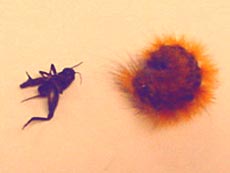
Step
one is to purchase an emulsifiable concentrate of diazinon (liquid
form). Dilute with water to make a .5 percent solution for a
foundation spray. The average home requires about three gallons of
spray solution, so you will need about eight ounces of 25 percent
diazinon concentrate in three gallons of water to get the correct
percentage.
Step
two is to spray the foundation of the house just to the point of
runoff. Spray all the way around the house. Also make sure to spray
around the base of door openings.
[to top of second column in this
article]
|
Step
three is to also spray a 10- to 12-inch band of the solution on the
adjacent soil. A wider band may give better protection but also has
the extra insecticide involved. A wider band may be helpful if there
is a flower bed or shrubbery providing for more insects close to the
house.
Step
four is to spray behind concrete steps and other structures that
join up with the foundation. If you can’t spray behind them, spray
over and around them.
Step
five is to spray cracks and crevices in the foundation and in
concrete slabs (such as driveways) that join the foundation.
The
idea is to crate a continuous barrier that insects, spiders,
millipedes and other pests have to crawl through to get into your
house. Even if they do get in, they won’t last long. Once insects
are in the home, you shouldn’t use anything other than aerosol
products that are labeled for use in the home. Many of the products
just kill things that they come in contact with. A few do have a
lasting residual. Remember that the more residual pesticides have,
the more chances for accidentally causing poisoning problems.
Any
time that you are dealing with pesticides, you should read the
label. The label is a legal document that should tell what it
controls, how to mix, how to apply, safety precautions and other
important information.
Good
luck to you as we enter fall and try to keep those nuisance pests
out of your home.
[John
Fulton]
|
|
The
top award winners in the major award categories include the
following:
1.
The "I Dare You" award is presented to 4-H’ers who have
demonstrated qualities of leadership, excellence in character and
effective future leadership. This year’s winners were Hans Bishop
of Atlanta and Annie Davison of New Holland.
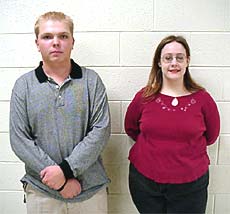
["I Dare You" and Key Award winners]
2.
The 4-H Key Award is the highest award given. The qualifications are
to be 16 years of age, have a minimum of three years of 4-H
membership, submit a 4-H story and meet nine other requirements as
verified by their leaders. Mary Healy of Middletown won this year.
3.
Some 4-H’ers are chosen each year in special award categories. A
book is presented to a 4-H’er with outstanding work, quantity,
quality, years, citizenship, leadership, participation, skill
acquisition and growth. The books are given in three age categories:
8-11 years of age, 12-14 and 15-19. A Blue Award is given to a 4-H’er
deserving of repeat recognition in a category. Winners are listed
below by categories.
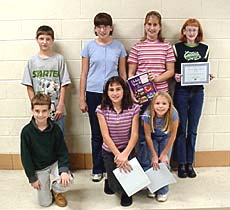
[Award winners, ages 8-11]
Achievement
8-11
years old — Book: Jenna Opperman, Lincoln
12-14
— Book: Andrew Fulton, Lincoln
15-19
— Book: Emily Bakken, Lincoln. Blue Awards: Jackie Bakken,
Lincoln; Hans Bishop, Atlanta
Animal
science
8-11
— Book: Shelden Tibbs, Middletown. Blue Awards: Kelly Cross,
Hartsburg; Allicent Pech, Lincoln
12-14
— Book: Andrew Fulton
15-19
— Book: Abby Sasse, Beason. Blue Awards: Jackie Bakken, Lincoln;
John Davison, Beason; Candice McKown, Atlanta
Community
involvement and global awareness
8-11
— Book: Zack Huffer, Lincoln
15-19
— Blue Award: Mark Cochran, Mount Pulaski
Environment-natural
resources
8-11
— Book: Ben Buse, Beason. Blue Award: Zack Huffer, Lincoln
15-19
— Book: Kyle Janssen, Middletown. Blue Award: Zac Tibbs,
Middletown

Food,
nutrition and health
8-11
— Book Award: Jenna Opperman, Lincoln. Blue Award: Kelly Gosda,
Lincoln
12-14
— Book: Chris Ackerman, Lincoln
15-19
— Book: Amanda Davison, Beason. Blue Award: Jackie Bakken, Lincoln
Home
and family
8-11
— Book: Allicent Pech, Lincoln. Blue Award: Nichole Benz, Lincoln
12-14
— Book: Katelyn Beavers, Broadwell
15-19
— Book: Amanda Davison, Beason. Blue Award: Jackie Bakken, Lincoln
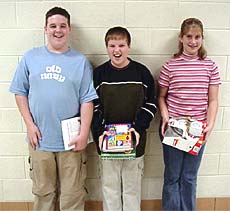
[Award winners, ages 12-14]
Leadership
12-14
— Book: Andrew Fulton, Lincoln
15-19
— Book: Kyle Janssen, Middletown
Mechanics
and technology
8-11
— Book: Zack Huffer, Lincoln
12-14
— Book: Andrew Fulton, Lincoln
15-19
— Book: Hans Bishop, Atlanta. Blue Awards: Hans Bishop, Atlanta;
John Davison, Beason

[to top of second column in
this article]
|

Personal
development
8-11
— Book: Jenna Opperman, Lincoln
12-14
— Book: Andrew Fulton, Lincoln. Blue Award: Audra Ballinger,
Atlanta
15-19
— Book: Amanda Davison, Beason. Blue Award: Jackie Bakken,
Lincoln; Leila Ballinger, Atlanta; John Davison, Beason
Plant
and soil science
8-11
— Book: Kim Turner, Atlanta
12-14
— Book: Scott Ubbenga, Hartsburg
15-19
— Book: Mary Healy, Middletown. Blue Awards: Hans Bishop, Atlanta;
John Davison, Beason; Zac Tibbs, Middletown
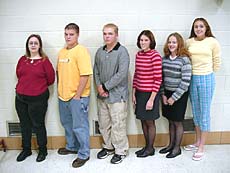
[Award winners, ages 15-19]
Club
awards
Club
community involvement and global awareness — Middletown 4-H’ers
Club
food, nutrition and wellness — The Pioneers
Club
standards of excellence — Atlanta Town & Country, Beason Ag,
Chester 4-H, Clover Kids, Cloverdale 4-H, Hartem Achievers,
Middletown 4-H’ers, Millennium Clovers, The Pioneers
Club
of the year — Chester 4-H
Top
food awards
Junior
foods winner — Jenna Opperman, Lincoln
Senior
foods winner — Emily Bakken, Lincoln
Leaders
recognized
Twenty
adult volunteers were recognized and honored at the Logan County 4-H
Achievement Night. By categories, the honors are as follows:
Leader
of the year — Mary Jo Janssen, Middletown

First
year leaders — Beth Allen, Pawnee; Carlene Carter, Lincoln; Ed
Carter, Lincoln; Christie Cross, Hartsburg; Kristen Helton,
Middletown; Sharon Jones, Lincoln; Dana Oltmanns, Lincoln; Debra
Wagner, Emden
Fifth
year leaders — Stanley Anderson, Elkhart; Cindy Gleason,
Hartsburg; Cindy Leesman, Atlanta; Mark Leesman, Atlanta; Betsy Pech,
Lincoln
10th
year leaders — Barbara Duckworth, Emden; Ann Olson, Elkhart;
Brenda Osborn, Hartsburg; Joyce Westen, Hartsburg; Lisa Wrage, Emden
15th
year leader — Rita Scanavino
20th
year leader — Tammy Buse
25th
year leaders — Georgia Green, Atlanta; Mary Jo Janssen, Middletown
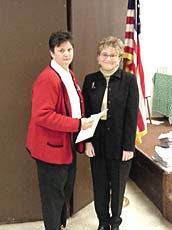
Congratulations!
For
a complete listing of the 4-H awards presented on Nov. 1 or for
information on the Logan County 4-H program, please contact the
Logan County 4-H office at 980 N. Postville Drive, Lincoln, IL 62656
or call (217) 732-8289.

|